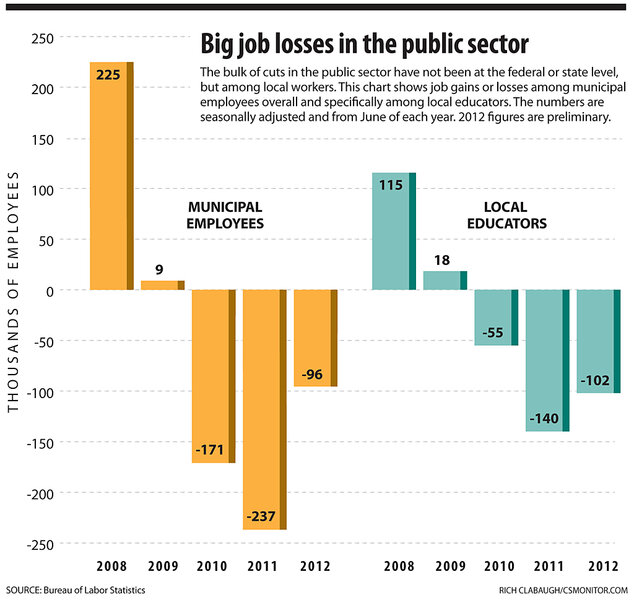Public-sector belt-tightening: thrift, or long-term drag on US economy?
Loading...
| Liberty Township, Ohio
This summer, firefighter Brian Lykins canceled his vacation to Nashville, horseback-riding summer camp for one daughter, and summer softball for another daughter. As for eating out: "It's something we seldom get to do," he says.
The reason: Mr. Lykins, a single father with three young daughters, was laid off Jan. 1 from his full-time job in Middletown, Ohio, where he had been working since 2010. Now, he works part time for two fire departments but gets half the pay and no health-care benefits.
"And on top of that, the fridge died in April," he says.
Lykins is hardly the only public employee encountering such challenges. For three years, city governments have been shrinking their workforces. Most communities pay their municipal employees and fund their schools and other services using tax revenues and fees collected for licenses and other things. But with home prices falling six consecutive years, property taxes are falling. And for states that have income-tax collections, the overall high unemployment rate has also eaten into revenue.
The resulting cuts in local government have subtracted almost one-quarter of a percentage point from annual gross domestic product (adjusted for inflation) each of the past four years, Moody's Analytics estimates. The total impact during that period: about $150 billion. Moreover, the cuts have accelerated over the past year, according to Moody's.
These reductions, economists say, act as a drag on the economy. Former park employees, clerks, and firefighters such as Lykins are buying only the necessities. Cities are deferring road work, which means contractors aren't hiring people to pour concrete. By far, the largest impact is on school systems, which are laying off teachers, counselors, and janitors.
Last Friday, in its advance estimate of GDP, the Bureau of Economic Analysis reported that economic growth in the second quarter rose by a modest 1.5 percent on an annual basis. One reason the BEA cited for the lackluster performance: “a negative contribution from state and local government spending.”
Some worry about the potential for longer-term ramifications, such as children falling behind their overseas peers, and companies building factories in other countries that have better roads for doing business.
"There is a legitimate debate about the cost structure of state and local government," says chief economist Mark Zandi of Moody's Analytics in West Chester, Pa. "But people lose sight of the fact that economic competitiveness is not just the tax rate, but the skill of workers and the quality of our infrastructure from the roads and bridges to our telecommunications, airports, and electric grid. All those things matter a lot to business."
A poll by CBS News/New York Times in mid-July found the public was almost evenly split on the issue of reducing local services if it meant lower taxes. However, when asked specifically about reducing the number of firefighters, police, even libraries and parks, most people said they were unwilling to make cuts.
What communities do spend on goods and services is of no small importance to the US economy. For example, police departments typically replace half their cruisers each year. Municipalities outsource road repair to contractors. Many cities hire companies to provide meals for their jails and schools.
"A lot of the private sector depends on the public sector," says Chris Hoene, director of research and innovation at the National League of Cities in Washington. "There are estimates that for every $3 spent at the municipal level, there is $1 in new private-sector activity."
The presidential candidates have both made statements recently about public-sector employment and spending, offering divergent views. In a speech in June, President Obama lamented the cuts made by state and local governments. "These are teachers and cops and firefighters," he said. "Congress should pass a bill putting them back to work right now, giving help to the states so that those layoffs are not occurring."
But presumptive GOP nominee Mitt Romney paints Mr. Obama as a "big government" president intent on building up bureaucracies. If elected president, Mr. Romney says his approach would be to move federal programs to the states or the private sector where, he maintains, they can be run more efficiently. "And streamline everything that's left," he said in a speech May 15 in Iowa.
The government sector has lost 627,000 jobs since June 2009, according to the US Bureau of Labor Statistics (BLS). The bulk of the cuts – some 504,000 – has not been at the federal or state level, but among local workers.
Even when they are not bracing for layoffs, many employees in the public sector have gone years without a pay increase. In Arizona, state workers have not had pay raises for five years. Florida state employees have had their pay frozen for six straight years. And in California, where there have been no raises for two years, many state employees also took pay cuts through furloughs. This year, Gov. Jerry Brown (D) is seeking a temporary 5 percent pay cut from the workers.
Although state revenues have shown some signs of gradual recovery, they are not growing sufficiently to keep pace with the expenditures required by Medicaid, pensions and other obligations, according to a recent report by the State Budget Crisis Task Force. The task force was co-chaired by former Federal Reserve Chairman Paul Volcker and former New York Lt. Gov. Richard Ravitch.
"State tax bases have eroded and become more volatile; these developments are undermining fiscal sustainability," reads one conclusion in the report, which was issued in mid-July.
Municipal revenues aren't doing any better. According to a survey by the National League of Cities last September, such revenues have fallen for five straight years and are expected to continue shrinking this year.
When revenue falls, officials have to make tough choices. That's what is happening in Tampa, Fla., where Mayor Bob Buckhorn faces a $24 million gap in his 2012-13 budget.
"The problem is that we've cut all the low-hanging fruit," he says. "So I've asked every department to show me what happens if we have to cut by 5 percent, 10 percent, or 15 percent."
As Mr. Buckhorn found out, a 15 percent reduction would mean the elimination of 700 employees out of a base of 4,200. "That's pretty draconian. We're already cutting into the bone," the Democrat says.
Instead, Buckhorn is cutting another 5 percent. Among his moves: He won't fill 29 vacant positions. "If it hasn't been filled in six months, it's not mission critical," he says.
He would prefer not to eliminate jobs, since most of the reductions happen at the lower levels. "In this economy, that's a death sentence to a low-level employee," he says.
Yet it's not just parks-and-recreation workers losing their jobs. According to the BLS, 297,000 education jobs have been lost since June 2009. That's 59 percent of all local public-sector jobs lost during that period.
Teacher cuts have certainly rippled through Ohio, where Gov. John Kasich (R), dealing with an $8 billion, two-year budget gap, has curtailed the overall funds sent to counties and cities.
On Jan. 1, the city of Monroe, Ohio, notified 30 education staff members that they would be out of a job at the end of the school year. The main cuts were in noncore classes such as art and music.
"We're eating our seed corn," says Suzi Rubin, a council member in Monroe.
One who lost his job is Tom Burklow, a high school teacher with 13 years of experience who had been teaching business technology.
Mr. Burklow, who says he loved the staff and small-school environment, doubts he will be able to land another teaching job in the area, since so many other school districts are also reducing their staffs.
"I've heard about a few spots where there are openings, but both schools said they are not going to fill the jobs," he says. "I don't understand, since schools are our intellectual infrastructure."
Since he has normally been off for the summer, his jobless state has yet to sink in. "I have filed for unemployment; it's the first time I've ever done that," he says. "I think the most immediate impact is that I want to be doing something. Just sitting around the house looking at the dog makes me feel like I'm falling behind."
Still, some elected officials in Ohio see ways that budget cuts have actually helped their towns. In Mount Sterling (pop. 1,700), laying off the entire police force of five deputies and a dispatcher saved the town money, after it contracted with the county sheriff to provide police protection, Mayor Charlie Neff says.
"Now we don't have to worry about buying new police cruisers, setting aside money for retirement, upkeep of equipment, training expenses, or any lawsuits against the police," he says. "The sheriff saves us money and gives us better service."
This is not to say there is no crime in the rural community, which on the surface looks more like a Norman Rockwell small town in need of a paint job. Law enforcement officials recently busted a drug ring in the town, Mr. Neff says.
In the view of some elected officials, communities may have expanded too much in the past and now need to tighten their belts.
"From our standpoint, a lot of local communities went beyond what they needed to do," says Mark Fitzgerald, a council member in the city of Loveland, Ohio. "They built golf courses, added cable TV services," he explains at a dinner with other local legislators.
But Ms. Rubin, the council member in Monroe, worries about the impact of cuts on firehouses and roads. "Once you stop repairing the roads, you never get caught up," she says, adding that cutting too deeply may cost future private-sector jobs.
"Businesses want water. They want services. And if the infrastructure is not there, they are not coming," Rubin says.
Lykins, the firefighter, can attest to how cuts in critical services can affect communities. Last month, on three occasions, Middletown asked one of the fire stations where he now works to help with fires. Middletown is 12 to 15 miles away, and it takes his unit in Liberty Township about 20 to 25 minutes to get there. Typically, a fire department tries to respond to a call in four to six minutes.
"The quicker you get there and can get some water on it, the quicker you can put the fire out," Lykins says.







